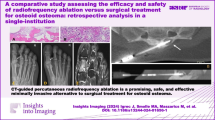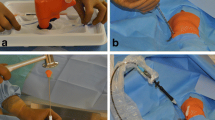Abstract
Introduction
The aim of the study was to compare decompression of bone-marrow edema or osteonecrosis of the proximal femur by means of a cone beam-based imaging and navigation system (cone beam-navigated decompression, CBND) with decompression by the conventional technique of drilling using fluoroscopy (FD).
Materials and methods
The data of patients with bone-marrow edema syndrome treated between 2016 and 2018 by drilling of the proximal femur in CBND or FD technique were compared retrospectively.
Results
Each treatment group included 20 patients. The mean operating time for CBND was 16.4 ± 5.8 min, compared with 29.1 ± 20.8 min for FD (p = 0.018). The lesion was definitely reached by CBND in 19/20 patients. Eighteen of the 20 patients in the CBND group reported that their pain decreased after the treatment, compared with 12/20 patients in the FD group (p = 0.065). The radiation dosage was significantly higher (p < 0.001) for CBND than for FD.
Conclusion
Decompression by CBND can be carried out safely and without complications. The advantages of CBND over FD are the minimally invasive access and the ability to address the affected area precisely with only one drilling maneuver. The high radiation dose of CBND can be reduced using low-dose protocols.




Similar content being viewed by others
References
Claßen T, Becker A, Landgraeber S et al (2016) Long-term clinical results after iloprost treatment for bone marrow edema and avascular necrosis. Orthop Rev (Pavia) 8:6150
Pountos I, Giannoudis PV (2018) The role of Iloprost on bone edema and osteonecrosis: safety and clinical results. Expert Opin Drug Saf 17:225–233
Aigner N, Schneider W, Eberl V et al (2002) Core decompression in early stages of femoral head osteonecrosis—an MRI-controlled study. Int Orthop 26:31–35
Arand M, Schempf M, Kinzl L et al (2001) Precision in standardized Iso-C-Arm based navigated boring of the proximal femur. Unfallchirurg 104:1150–1156
Beckmann J, Tingart M, Perlick L et al (2007) Navigated drilling for femoral head necrosis. Experimental and clinical results. Orthopade 36:458–465
Balling H (2018) Learning curve analysis of 3D-fluoroscopy image-guided pedicle screw insertions in lumbar single-level fusion procedures. Arch Orthop Trauma Surg 138:1501–1509
Vulpiani MC, Vetrano M, Trischitta D et al (2012) Extracorporeal shock wave therapy in early osteonecrosis of the femoral head: prospective clinical study with long-term follow-up. Arch Orthop Trauma Surg 132:499–508
Roth A, Beckmann J, Bohndorf K et al (2016) S3-Guideline non-traumatic adult femoral head necrosis. Arch Orthop Trauma Surg 136:165–174
Zippelius T, Perka C, Preininger B et al (2018) Long-term effects of intravenous iloprost therapy in patients with bone marrow oedema of the hip. Acta Orthop Belg 84:172–178
Roth A, Beckmann J, Bohndorf K et al (2018) Update of the German S3 guideline on atraumatic femoral head necrosis in adults. Orthopade 47:757–769
Mont MA, Carbone JJ, Fairbank AC (1996) Core decompression versus nonoperative management for osteonecrosis of the hip. Clin Orthop Relat Res 324:169–178
Steinberg ME, Larcom PG, Strafford B et al (2001) Core decompression with bone grafting for osteonecrosis of the femoral head. Clin Orthop Relat Res 386:71–78
Sun W, Li ZR, Wang BL et al (2014) Relationship between preservation of the lateral pillar and collapse of the femoral head in patients with osteonecrosis. Orthopedics 37:e24–e28
Maus U, Roth A, Tingart M et al (2015) S3 Guideline. Part 3: non-traumatic avascular necrosis in adults—surgical treatment of atraumatic avascular femoral head necrosis in adults. Z Orthop Unfall 153:498–507
Hur JW, Kim JS, Ryu KS et al (2019) Accuracy and safety in screw placement in the high cervical spine: retrospective analysis of O-arm-based navigation-assisted C1 lateral mass and C2 pedicle screws. Clin Spine Surg 32:E193–E199
Ohnsorge JA, Portheine F, Mahnken AH et al (2003) Computer-assisted retrograde drilling of osteochondritic lesions of the talus with the help of fluoroscopic navigation. Z Orthop Ihre Grenzgeb 141:452–458
Ohnsorge JA, Schkommodau E, Wirtz DC et al (2003) Accuracy of fluoroscopically navigated drilling procedures at the hip. Z Orthop Ihre Grenzgeb 141:112–119
Beckmann J, Goetz J, Baethis H et al (2006) Precision of computer-assisted core decompression drilling of the femoral head. Arch Orthop Trauma Surg 126:374–379
Beckmann J, Schmidt T, Schaumburger J et al (2013) Infusion, core decompression, or infusion following core decompression in the treatment of bone edema syndrome and early avascular osteonecrosis of the femoral head. Rheumatol Int 33:1561–1565
Funding
No funding was received for this study.
Author information
Authors and Affiliations
Corresponding author
Ethics declarations
Conflict of interest
All authors declare that they have nothing to disclose.
Additional information
Publisher's Note
Springer Nature remains neutral with regard to jurisdictional claims in published maps and institutional affiliations.
Rights and permissions
About this article
Cite this article
Zippelius, T., Strube, P., Matziolis, G. et al. Cone beam-navigated core decompression of bone marrow edema syndrome. Arch Orthop Trauma Surg 140, 1603–1609 (2020). https://doi.org/10.1007/s00402-020-03339-0
Received:
Published:
Issue Date:
DOI: https://doi.org/10.1007/s00402-020-03339-0




